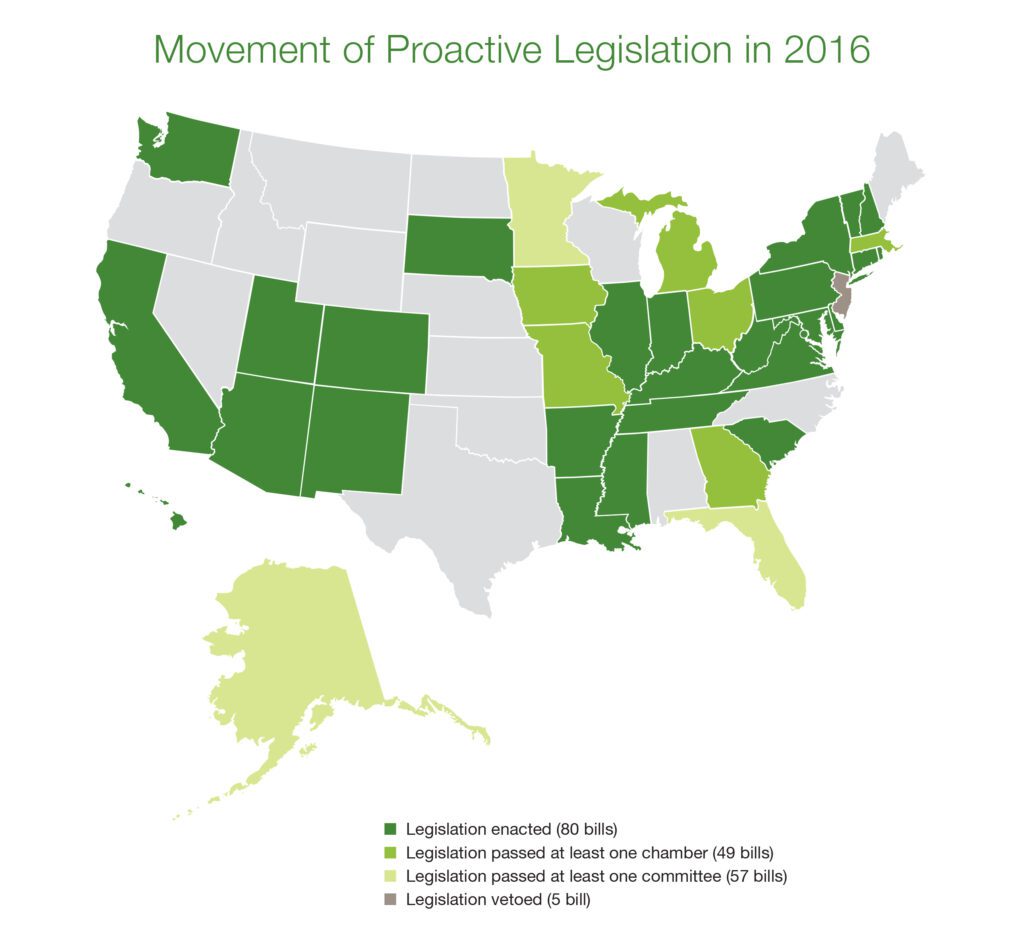2016 Proactive Year in Review
[fusion_builder_container hundred_percent=”yes” overflow=”visible”][fusion_builder_row][fusion_builder_column type=”1_1″ background_position=”left top” background_color=”” border_size=”” border_color=”” border_style=”solid” spacing=”yes” background_image=”” background_repeat=”no-repeat” padding=”” margin_top=”0px” margin_bottom=”0px” class=”” id=”” animation_type=”” animation_speed=”0.3″ animation_direction=”left” hide_on_mobile=”no” center_content=”no” min_height=”none”][fusion_text]
Gaining Ground: Proactive Reproductive Health and Rights Legislation in the States is the National Institute’s third annual report analyzing proactive legislation from the previous year.
Even though two-thirds of statehouses were dominated by opponents of reproductive health and rights in 2016, advocates and legislators in 36 states and the District of Columbia moved 191 proactive pieces of legislation aimed at improving women’s lives.
This report focuses on four distinct policy areas:
- Protecting and expanding access to abortion, contraception, and sexual health care;
- Enhancing insurance coverage for reproductive and sexual health care;
- Improving the reproductive and sexual health of youth;
- Promoting healthy pregnancies, parents, and infants.
To see the expansion of proactive reproductive health and rights policies in the states over the last few years, download our 2014 proactive policy report and our 2015 proactive policy report.
[/fusion_text][fusion_separator style_type=”none” top_margin=”” bottom_margin=”” sep_color=”” icon=”” width=”” class=”” id=””/][fusion_text] [/fusion_text][fusion_separator style_type=”none” top_margin=”30″ bottom_margin=”” sep_color=”” icon=”” width=”” class=”” id=””/][/fusion_builder_column][fusion_builder_column type=”1_1″ background_position=”left top” background_color=”” border_size=”” border_color=”” border_style=”solid” spacing=”yes” background_image=”” background_repeat=”no-repeat” padding=”” margin_top=”0px” margin_bottom=”0px” class=”” id=”” animation_type=”” animation_speed=”0.3″ animation_direction=”left” hide_on_mobile=”no” center_content=”no” min_height=”none”][fusion_title size=”2″ content_align=”left” style_type=”single solid” sep_color=”” class=”” id=””]2016 Key Takeaways:[/fusion_title][/fusion_builder_column][fusion_builder_column type=”1_1″ background_position=”left top” background_color=”” border_size=”” border_color=”” border_style=”solid” spacing=”yes” background_image=”” background_repeat=”no-repeat” padding=”” margin_top=”0px” margin_bottom=”0px” class=”” id=”” animation_type=”” animation_speed=”0.3″ animation_direction=”left” hide_on_mobile=”no” center_content=”no” min_height=”none”][fusion_checklist icon=”fa-star” iconcolor=”#94bf3e” circle=”” circlecolor=”#” size=”small” class=”” id=””][fusion_li_item icon=”fa-star”]Thirty-six states and the District of Columbia proposed or enacted policies in 2016 aimed at improving reproductive and sexual health. [/fusion_li_item][fusion_li_item icon=”fa-star”]State legislators advanced 191 proactive policies through at least one committee. [/fusion_li_item][fusion_li_item icon=”fa-star”]A total of 80 affirmative reproductive health policies passed, up from 30 just two years ago.[/fusion_li_item][fusion_li_item icon=”fa-star”]New trends included laws that would protect patient privacy, allow pregnant women to stay on the job, and enable parenting students to take sick leave.[/fusion_li_item][/fusion_checklist][fusion_separator style_type=”none” top_margin=”30″ bottom_margin=”” sep_color=”” icon=”” width=”” class=”” id=””/][/fusion_builder_column][fusion_builder_column type=”1_1″ background_position=”left top” background_color=”” border_size=”” border_color=”” border_style=”solid” spacing=”yes” background_image=”” background_repeat=”no-repeat” padding=”” margin_top=”0px” margin_bottom=”0px” class=”” id=”” animation_type=”” animation_speed=”0.3″ animation_direction=”left” hide_on_mobile=”no” center_content=”no” min_height=”none”][fusion_title size=”2″ content_align=”left” style_type=”single solid” sep_color=”” class=”” id=””]Five Proactive Policies That Moved in 2016:[/fusion_title][/fusion_builder_column][fusion_builder_column type=”1_1″ background_position=”left top” background_color=”” border_size=”” border_color=”” border_style=”solid” spacing=”yes” background_image=”” background_repeat=”no-repeat” padding=”” margin_top=”0px” margin_bottom=”0px” class=”” id=”” animation_type=”” animation_speed=”0.3″ animation_direction=”left” hide_on_mobile=”no” center_content=”no” min_height=”none”][fusion_checklist icon=”fa-star” iconcolor=”#94bf3e” circle=”” circlecolor=”#” size=”small” class=”” id=””][fusion_li_item icon=””]Ensuring that patients receive timely access to abortion and other reproductive health care and information by requiring that even when a medical provider has an objection to providing some types of medical care, including abortion, the patient can still access it. (IL) [/fusion_li_item][fusion_li_item icon=”fa-star”]Protecting privacy in abortion and other reproductive health care by ensuring that confidential information about an individual’s health care, including abortion care, is sent directly to that person, not to the person who holds the insurance policy. (MA) [/fusion_li_item][fusion_li_item icon=”fa-star”]Protecting and expanding access to contraception, including by requiring contraceptive coverage with no cost sharing, without delays or barriers, and/or providing coverage for 12 months of contraception with one prescription. (CA, HI, IL, MD, VT, WV)[/fusion_li_item][fusion_li_item icon=”fa-star”]Protecting and promoting the health of incarcerated pregnant women by prohibiting shackling, requiring prisons and jails to meet health and nutrition standards for pregnant prisoners, and following through on all of those guarantees after they are enacted into law. (MA, MD, NY)[/fusion_li_item][fusion_li_item icon=””]Creating programs to address maternal mortality. (SC, TN, WA)[/fusion_li_item][/fusion_checklist][fusion_separator style_type=”none” top_margin=”30″ bottom_margin=”” sep_color=”” icon=”” width=”” class=”” id=””/][/fusion_builder_column][fusion_builder_column type=”1_1″ background_position=”left top” background_color=”” border_size=”” border_color=”” border_style=”solid” spacing=”yes” background_image=”” background_repeat=”no-repeat” padding=”” margin_top=”0px” margin_bottom=”0px” class=”” id=”” animation_type=”” animation_speed=”0.3″ animation_direction=”left” hide_on_mobile=”no” center_content=”no” min_height=”none”][fusion_title size=”2″ content_align=”left” style_type=”single solid” sep_color=”” class=”” id=””]Five Bold Ideas for 2017:[/fusion_title][/fusion_builder_column][fusion_builder_column type=”1_1″ background_position=”left top” background_color=”” border_size=”” border_color=”” border_style=”solid” spacing=”yes” background_image=”” background_repeat=”no-repeat” padding=”” margin_top=”0px” margin_bottom=”0px” class=”” id=”” animation_type=”” animation_speed=”0.3″ animation_direction=”left” hide_on_mobile=”no” center_content=”no” min_height=”none”][fusion_checklist icon=”fa-star” iconcolor=”#94bf3e” circle=”” circlecolor=”#” size=”small” class=”” id=””][fusion_li_item icon=”fa-star”]Promote healthy women and families by enacting legislation that provides comprehensive insurance coverage for the full range of reproductive health care, including contraception and abortion, prenatal care, postpartum care, and breastfeeding support and supplies for all women, regardless of where their insurance comes from or their immigration status.[/fusion_li_item][fusion_li_item icon=”fa-star”]Ensure that abortion patients receive medically accurate and appropriate care by allowing doctors to provide only scientifically supported information and care and enabling patients to refuse biased, misleading, or unnecessary information, testing, and protocols.[/fusion_li_item][fusion_li_item icon=”fa-star”]Protect abortion patients and providers by keeping their personal information confidential, allowing them to sue those who harass them to prevent further harassment and violence, and working with law enforcement to ensure that those who are tasked with protecting clinics are equipped with the training and information they need to do so.[/fusion_li_item][fusion_li_item icon=”fa-star”]Ensure access to abortion care by prohibiting restrictions that do not provide legitimate health benefits, and by removing existing laws that impose those burdens.[/fusion_li_item][fusion_li_item icon=”fa-star”]Expand access to reproductive health care for women in rural areas by allowing for the provision of health services, including medication abortion, through telemedicine.[/fusion_li_item][/fusion_checklist][/fusion_builder_column][/fusion_builder_row][/fusion_builder_container]
[/fusion_text][fusion_separator style_type=”none” top_margin=”30″ bottom_margin=”” sep_color=”” icon=”” width=”” class=”” id=””/][/fusion_builder_column][fusion_builder_column type=”1_1″ background_position=”left top” background_color=”” border_size=”” border_color=”” border_style=”solid” spacing=”yes” background_image=”” background_repeat=”no-repeat” padding=”” margin_top=”0px” margin_bottom=”0px” class=”” id=”” animation_type=”” animation_speed=”0.3″ animation_direction=”left” hide_on_mobile=”no” center_content=”no” min_height=”none”][fusion_title size=”2″ content_align=”left” style_type=”single solid” sep_color=”” class=”” id=””]2016 Key Takeaways:[/fusion_title][/fusion_builder_column][fusion_builder_column type=”1_1″ background_position=”left top” background_color=”” border_size=”” border_color=”” border_style=”solid” spacing=”yes” background_image=”” background_repeat=”no-repeat” padding=”” margin_top=”0px” margin_bottom=”0px” class=”” id=”” animation_type=”” animation_speed=”0.3″ animation_direction=”left” hide_on_mobile=”no” center_content=”no” min_height=”none”][fusion_checklist icon=”fa-star” iconcolor=”#94bf3e” circle=”” circlecolor=”#” size=”small” class=”” id=””][fusion_li_item icon=”fa-star”]Thirty-six states and the District of Columbia proposed or enacted policies in 2016 aimed at improving reproductive and sexual health. [/fusion_li_item][fusion_li_item icon=”fa-star”]State legislators advanced 191 proactive policies through at least one committee. [/fusion_li_item][fusion_li_item icon=”fa-star”]A total of 80 affirmative reproductive health policies passed, up from 30 just two years ago.[/fusion_li_item][fusion_li_item icon=”fa-star”]New trends included laws that would protect patient privacy, allow pregnant women to stay on the job, and enable parenting students to take sick leave.[/fusion_li_item][/fusion_checklist][fusion_separator style_type=”none” top_margin=”30″ bottom_margin=”” sep_color=”” icon=”” width=”” class=”” id=””/][/fusion_builder_column][fusion_builder_column type=”1_1″ background_position=”left top” background_color=”” border_size=”” border_color=”” border_style=”solid” spacing=”yes” background_image=”” background_repeat=”no-repeat” padding=”” margin_top=”0px” margin_bottom=”0px” class=”” id=”” animation_type=”” animation_speed=”0.3″ animation_direction=”left” hide_on_mobile=”no” center_content=”no” min_height=”none”][fusion_title size=”2″ content_align=”left” style_type=”single solid” sep_color=”” class=”” id=””]Five Proactive Policies That Moved in 2016:[/fusion_title][/fusion_builder_column][fusion_builder_column type=”1_1″ background_position=”left top” background_color=”” border_size=”” border_color=”” border_style=”solid” spacing=”yes” background_image=”” background_repeat=”no-repeat” padding=”” margin_top=”0px” margin_bottom=”0px” class=”” id=”” animation_type=”” animation_speed=”0.3″ animation_direction=”left” hide_on_mobile=”no” center_content=”no” min_height=”none”][fusion_checklist icon=”fa-star” iconcolor=”#94bf3e” circle=”” circlecolor=”#” size=”small” class=”” id=””][fusion_li_item icon=””]Ensuring that patients receive timely access to abortion and other reproductive health care and information by requiring that even when a medical provider has an objection to providing some types of medical care, including abortion, the patient can still access it. (IL) [/fusion_li_item][fusion_li_item icon=”fa-star”]Protecting privacy in abortion and other reproductive health care by ensuring that confidential information about an individual’s health care, including abortion care, is sent directly to that person, not to the person who holds the insurance policy. (MA) [/fusion_li_item][fusion_li_item icon=”fa-star”]Protecting and expanding access to contraception, including by requiring contraceptive coverage with no cost sharing, without delays or barriers, and/or providing coverage for 12 months of contraception with one prescription. (CA, HI, IL, MD, VT, WV)[/fusion_li_item][fusion_li_item icon=”fa-star”]Protecting and promoting the health of incarcerated pregnant women by prohibiting shackling, requiring prisons and jails to meet health and nutrition standards for pregnant prisoners, and following through on all of those guarantees after they are enacted into law. (MA, MD, NY)[/fusion_li_item][fusion_li_item icon=””]Creating programs to address maternal mortality. (SC, TN, WA)[/fusion_li_item][/fusion_checklist][fusion_separator style_type=”none” top_margin=”30″ bottom_margin=”” sep_color=”” icon=”” width=”” class=”” id=””/][/fusion_builder_column][fusion_builder_column type=”1_1″ background_position=”left top” background_color=”” border_size=”” border_color=”” border_style=”solid” spacing=”yes” background_image=”” background_repeat=”no-repeat” padding=”” margin_top=”0px” margin_bottom=”0px” class=”” id=”” animation_type=”” animation_speed=”0.3″ animation_direction=”left” hide_on_mobile=”no” center_content=”no” min_height=”none”][fusion_title size=”2″ content_align=”left” style_type=”single solid” sep_color=”” class=”” id=””]Five Bold Ideas for 2017:[/fusion_title][/fusion_builder_column][fusion_builder_column type=”1_1″ background_position=”left top” background_color=”” border_size=”” border_color=”” border_style=”solid” spacing=”yes” background_image=”” background_repeat=”no-repeat” padding=”” margin_top=”0px” margin_bottom=”0px” class=”” id=”” animation_type=”” animation_speed=”0.3″ animation_direction=”left” hide_on_mobile=”no” center_content=”no” min_height=”none”][fusion_checklist icon=”fa-star” iconcolor=”#94bf3e” circle=”” circlecolor=”#” size=”small” class=”” id=””][fusion_li_item icon=”fa-star”]Promote healthy women and families by enacting legislation that provides comprehensive insurance coverage for the full range of reproductive health care, including contraception and abortion, prenatal care, postpartum care, and breastfeeding support and supplies for all women, regardless of where their insurance comes from or their immigration status.[/fusion_li_item][fusion_li_item icon=”fa-star”]Ensure that abortion patients receive medically accurate and appropriate care by allowing doctors to provide only scientifically supported information and care and enabling patients to refuse biased, misleading, or unnecessary information, testing, and protocols.[/fusion_li_item][fusion_li_item icon=”fa-star”]Protect abortion patients and providers by keeping their personal information confidential, allowing them to sue those who harass them to prevent further harassment and violence, and working with law enforcement to ensure that those who are tasked with protecting clinics are equipped with the training and information they need to do so.[/fusion_li_item][fusion_li_item icon=”fa-star”]Ensure access to abortion care by prohibiting restrictions that do not provide legitimate health benefits, and by removing existing laws that impose those burdens.[/fusion_li_item][fusion_li_item icon=”fa-star”]Expand access to reproductive health care for women in rural areas by allowing for the provision of health services, including medication abortion, through telemedicine.[/fusion_li_item][/fusion_checklist][/fusion_builder_column][/fusion_builder_row][/fusion_builder_container]